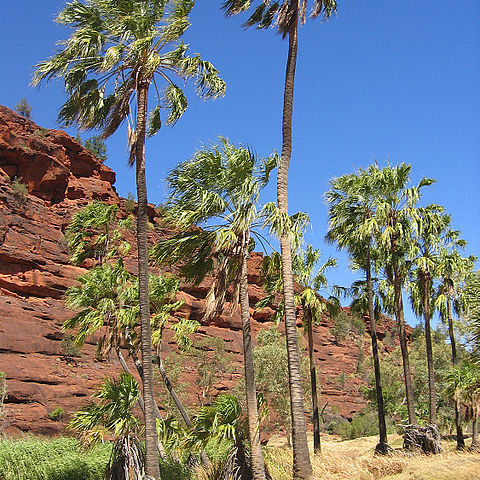Trunk to 30 m tall, 30–40 cm diam., grey; base with prominent petiole stubs, smooth above. Leaves 30–50 in a dense crown, obliquely erect to drooping; petiole 150–250 cm long, 20–45 mm wide, with small basal marginal thorns; leaf blade circular, 100–220 cm diam, coriaceous, grey-green and glossy adaxially, pruinose and glabrous abaxially, divided for c. 1/2 its length; segments 50–86, drooping distally, deeply bifurcate with attenuate lobes; distal segments overlapping; outer margin of distal segments prickly. Inflorescence 125–250 cm long, branched to 4 orders; bracts with dense white appressed scales; rachillae glabrous. Flowers in sympodial clusters of 3–6, campanulate, greenish cream; sepals ovate, 0.8–1 mm long, bluntly acute, membranous; petals broadly oblong, 1.2–1.5 mm long, acute; stamens c. 1.2 mm long. Fruit globose, 12–18 mm diam., semi-glossy, black. Seed oblate, 8–12 mm long.
More
A tall straight palm. Plants grow to about 20 m high. The trunk is 30 cm across. The trunk has rings and is pale grey. The base is swollen just above the ground. The crown in rounded. The leaves are finely divided and shiny green. They can be paler green and with a wax layer underneath. They are erect and spreading but can droop. They are divided for about half their length then divided again into finely pointed lobes which droop. Young plants have reddish leaves. The leaves are 2 m long and spiny on the edge near the base. The leaves are thick textured and heavily ribbed. The flowering stalk is long, erect and stout. They have tight bracts. The flowers are cream. The fruit are glossy black. They are round and 15-20 mm across.
A tropical plant. It occurs naturally near the Finke River in Central Australia. It grows in a moist situation surrounded by a hostile arid environment. It does best in tropical and subtropical locations. It can grow in inland areas with dry warm climate. It needs well drained soil. Plants can withstand full sun when small. In the Cairns Botanical Gardens. It suits hardiness zones 9-11.
More
Grows close to water along the banks of the river, whichin this locality runs mainly through a sandstone gorge.


